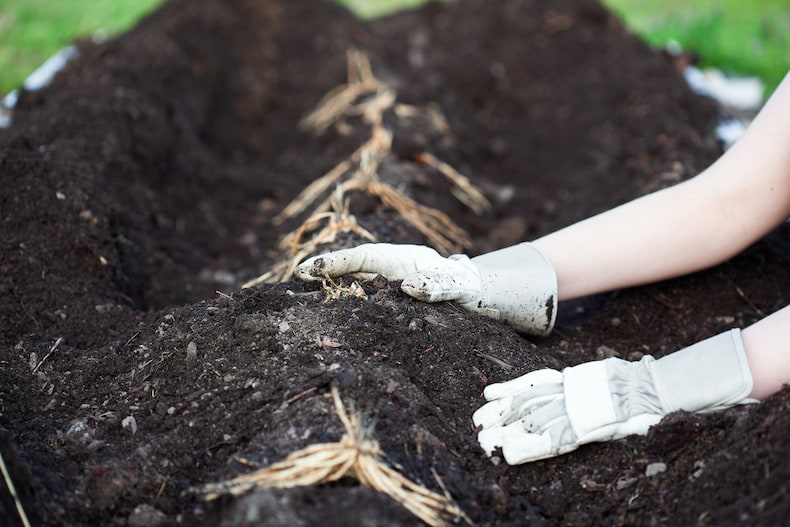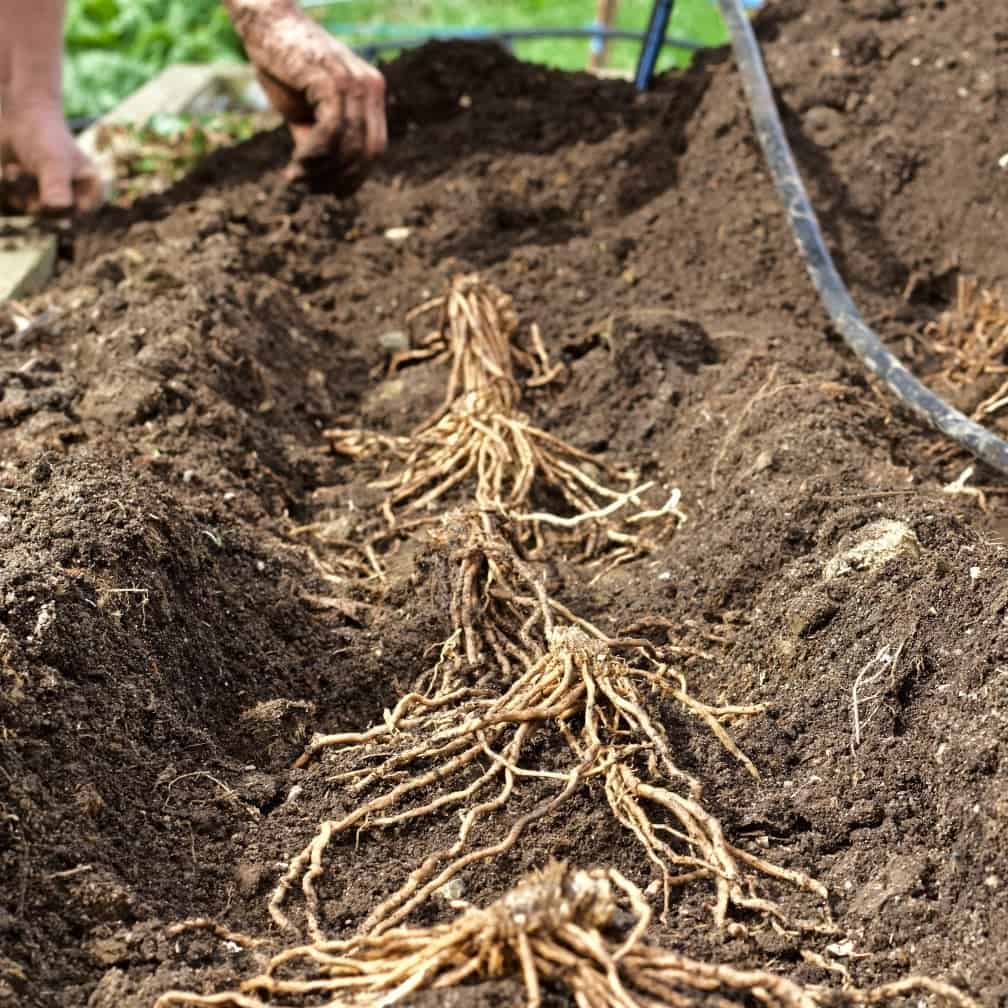To plant bare root asparagus, carefully dig a trench and space the crowns about 12-18 inches apart. Asparagus is a delicious and nutritious vegetable that can be easily grown in your own backyard.
Planting bare root asparagus is a simple and efficient way to establish a productive asparagus bed. When planting bare root asparagus, it’s important to follow a few key steps to ensure the success of your plants. We will guide you through the process of planting bare root asparagus, from preparing the soil to caring for the plants as they grow.

Credit: www.thompson-morgan.com
By following these steps, you’ll be well on your way to enjoying a bountiful harvest of fresh asparagus for years to come. So let’s get started!
How to Plant Bare Root Asparagus : Step by Step Guide
Selecting And Preparing The Asparagus Bed
Choosing the right location for your asparagus bed is crucial for successful planting. Look for a spot with full sun exposure, as asparagus requires at least 8 hours of direct sunlight each day. Ensure that the chosen area has well-drained soil to prevent waterlogging, which can lead to root rot.
Before planting, prepare the soil by removing any weeds, grass, or debris from the bed area. This will help prevent competition for nutrients and give your asparagus a better chance to establish and thrive. Testing the soil pH level is also important, as asparagus prefers a pH range between 6.0 and 7.0. Adjust the pH if necessary by adding organic matter or lime to achieve the desired level.
Note: It’s essential to clear any perennial weeds, such as quackgrass or bermudagrass, as they can quickly infest your asparagus bed. Taking this step will save you time and effort in the long run.
Planting Bare Root Asparagus
Planting bare root asparagus requires a few essential steps for successful growth. Soaking the bare root asparagus crowns in water for a couple of hours before planting can help hydrate them and improve their chances of survival. Avoid letting the crowns dry out during planting to prevent stress.
Next, it’s crucial to dig trenches of appropriate width and depth for the asparagus crowns. The trenches should be about 6-8 inches deep, allowing enough space for root growth. Consider spacing the crowns around 18 inches apart to provide ample room for the asparagus plants to flourish.
Once the trenches are ready, position the bare root asparagus crowns in the trenches with the bud side facing up and the roots spread out below. Gently fill the trench with soil while taking care not to damage the crowns. Maintaining a depth of around 2 inches above the crowns is essential.
Proper positioning and planting of bare root asparagus crowns in well-prepared trenches are vital to ensure healthy growth. Following these steps and providing the necessary care will result in a bountiful harvest of delicious asparagus.
Caring For Bare Root Asparagus Plants
Planting bare root asparagus requires proper care to ensure successful growth and harvest. One important aspect of caring for bare root asparagus plants is mulching to control weeds and maintain moisture. Applying a layer of organic mulch around the plants helps suppress weeds and conserve moisture in the soil.
Regular watering is essential for optimal asparagus growth. The plants should receive one to two inches of water per week, either through rainfall or irrigation. Water deeply to encourage deep root development and avoid shallow watering.
Asparagus plants have nutrient requirements that can be met through fertilization. Applying a balanced fertilizer in early spring and again after harvest provides the necessary nutrients for healthy growth. Follow the recommended dosage and application instructions.
Lastly, monitoring and controlling pests and diseases is crucial for the well-being of bare root asparagus plants. Regularly inspect the plants for signs of pests or diseases, such as asparagus beetles or fungal infections. Use organic or chemical controls as needed.
Harvesting And Storing Asparagus
Harvesting and storing asparagus properly is crucial for maximizing yields and ensuring freshness and flavor retention. Determining the right time for harvesting asparagus is essential to enjoy its optimal taste and texture. It is recommended to harvest asparagus spears when they reach about 6-8 inches in height and have tight tips. Cut the spears at ground level, using a sharp knife or scissors, being careful not to damage the crowns.
To maximize yields, employ the “two-cut” or “snap” method. With the two-cut method, cut the asparagus spears just below the soil surface, while with the snap method, snap off the spears near the base. Both techniques help stimulate the growth of new spears.
After harvesting, it’s crucial to store asparagus properly to retain its freshness and flavor. Remove any rubber bands or ties and rinse the spears under cold water. To prevent wilting, store them upright in a jar or container with about an inch of water. Alternatively, wrap the spears in a damp paper towel, place them in a plastic bag, and refrigerate. Asparagus can usually be stored for up to a week, but its freshness is best retained when consumed within a few days.
Troubleshooting Common Asparagus Plant Issues
Growing asparagus can be a rewarding experience, but it’s not without its challenges. Here are some common issues that asparagus plants may face:
Identifying and Treating Asparagus Diseases
Asparagus diseases can weaken plants and affect their overall health. Common diseases include fusarium wilt, crown rot, and rust. To prevent these diseases, it is important to practice good garden hygiene, such as removing infected plant material and providing proper drainage. Fungicides may also be used to treat affected plants.
Dealing with Pest Infestations on Asparagus Plants
Pests like asparagus beetles and aphids can cause damage to asparagus plants. Regularly inspecting plants for signs of infestation, such as chewed foliage or sticky residue, is vital. Physical removal of pests, like handpicking or using a strong jet of water, can help control the problem. Alternatively, insecticidal soaps or neem oil can be used for organic pest control.
Managing Nutrient Deficiencies in Asparagus
Proper nutrition is crucial for healthy asparagus plants. Identifying nutrient deficiencies, such as nitrogen, phosphorus, or potassium deficiencies, can be done by observing leaf color and growth patterns. Adding composted manure or organic fertilizers can help replenish nutrient levels in the soil and promote vigorous plant growth.
Frequently Asked Questions Of How To Plant Bare Root Asparagus
Do You Soak Bare Root Asparagus Before Planting?
Yes, soaking bare root asparagus before planting is recommended for optimal growth and development.
How Far Apart Do You Plant Bare Root Asparagus?
Plant bare root asparagus approximately 12-18 inches apart for optimal spacing.
How Long Does It Take For Bare Root Asparagus To Sprout?
Bare root asparagus typically sprouts within 2-3 weeks after planting.
How Many Asparagus Roots Should I Plant?
Plant 1 asparagus root per square foot to ensure optimal growth and yield.
Conclusion
Planting bare root asparagus is a rewarding and relatively straightforward task that can yield delicious results for years to come. By following the step-by-step process, you can ensure the healthy growth and development of your asparagus plants. Start by preparing the soil, making sure it is rich in organic matter and well-drained.
Then, carefully plant the crowns at the appropriate depth, allowing space for their future expansion. Water the plants thoroughly after planting, and make sure to keep the soil consistently moist throughout the growing season. Regularly remove any weeds that may compete with the asparagus for nutrients and sunlight.
With proper care and maintenance, your asparagus plants will thrive and provide a bountiful harvest. So go ahead and start your own asparagus patch – you won’t be disappointed! Happy gardening!

